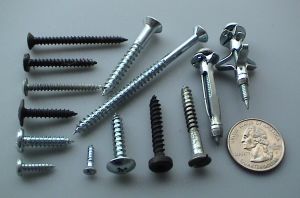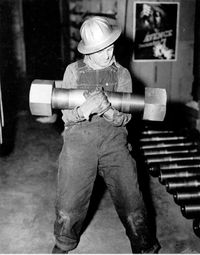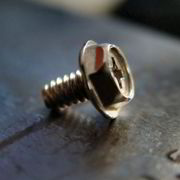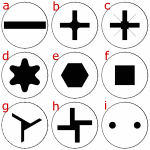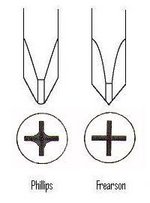Screw
2007 Schools Wikipedia Selection. Related subjects: Engineering
A screw is a shaft with a helical groove or thread formed on its surface. Its main uses are as a threaded fastener used to hold objects together, and as a simple machine used to translate torque into linear force. It can also be defined as an inclined plane wrapped around a shaft.
Threaded fastener
A screw used as a threaded fastener consists of a shaft, which may be cylindrical or conical, and a head. The shaft has a helical ridge or thread formed on it. The thread is essentially an inclined plane wrapped around a shaft. The thread mates with a complementary helix in the material. The material may be manufactured with the mating helix ( taps and dies), or the screw may create it when first driven in (a self-tapping screw). The head is specially shaped to allow a screwdriver or wrench (UK: spanner) to grip the screw when driving it in. It also stops the screw from passing right through the material being fastened and provides compression.
Screws can normally be removed and reinserted without reducing their effectiveness. They have greater holding power than nails and permit disassembly and reuse.
A screw that is tightened by turning it clockwise is said to have a right-hand thread. Screws with left-hand threads are used in exceptional cases, when the screw is subject to anticlockwise forces that might undo a right-hand thread. Examples include rotating items such as the left hand grinding wheel on a bench grinder or the left hand pedal on a bicycle (both looking towards the equipment).
Threaded fasteners are traditionally made by a cutting action such as taps and dies provide, however recent advances in tooling allows them to be made by rolling the blank (a section of rod) between two specially machined dies. The thread form and shape of the fastener are squeezed onto the blank. This method work hardens the threads and saves material. A rolled thread is obvious after manufacture because the outside diameter of the thread is greater than the diameter of the blank material. Bicycle spokes, which are just very long thin bolts, always use rolled threads for strength.
Bolt
A bolt is a cylindrical (as opposed to conical) threaded fastener that passes through the work piece and is held in place by a nut or a threaded hole on the other side. This is a very common way of holding together temporary and permanent constructions. An unthreaded hole is known as a clear hole. The thread on a bolt sometimes occupies only part of the shaft, the remainder of the shaft being clear; if the thread continues up to the head it is known as a 'set'.
See also the article on the bolt manufacturing process.
Other fastening methods
When screws and bolts cannot be used, nailing, riveting, roll pins, pinned shafts, welding, soldering, brazing, gluing, and duct tape (taping) are some alternatives.
Materials and strength
Screws and bolts are made in a wide range of materials, with steel being perhaps the most common, in many varieties. Where great resistance to weather or corrosion is required, stainless steel, titanium, brass or bronze may be used, or a coating such as brass, zinc or chromium applied. Electrolytic action from dissimilar metals can be prevented with aluminium screws for double-glazing tracks, for example. Some types of plastic, such as nylon or Teflon, can be threaded and used for fastening requiring moderate strength and great resistance to corrosion or for the purpose of electrical insulation. Even porcelain and glass can have molded screw threads that are used successfully in applications such as electrical line insulators and canning jars.
The same type of screw or bolt can be made in many different grades of material. For critical high-tensile-strength applications, low-grade bolts may fail, resulting in damage or injury. On SAE-standard bolts, a distinctive pattern of marking is impressed on the heads to allow inspection and validation of the strength of the bolt. However, low-cost counterfeit fasteners may be found with actual strength far less than indicated by the markings. Such inferior fasteners are a danger to life and property when used in aircraft, automobiles, heavy trucks, and similar critical applications.
Mechanical analysis
A screw is a specialized application of the wedge or inclined plane. It contains a wedge, wound around a cylinder or shaft, that either fits into a corresponding inclined plane in a nut, or forms a corresponding inclined plane in the wood or metal as it is inserted. The technical analysis (see also statics, dynamics) to determine the pitch, thread shape or cross section, coefficient of friction (static and dynamic), and holding power of the screw is very similar to that performed to predict wedge behaviour. Wedges are discussed in the article on simple machines.
Critical applications of screws and bolts will specify a torque that must be applied when tightening. The main concept is to stretch the bolt, and compress the parts being held together, creating a spring-like assembly. The stretch introduced to the bolt is called a preload. When external forces try to separate the parts, the bolt sees no strain unless the preload force is exceeded.
As long as the preload is never exceeded, the bolt or nut will never come loose (assuming the full strength of the bolt is used). If the full strength of the bolt is not used (e.g., a steel bolt threaded into aluminium threads), then a thread-locking adhesive may be used.
If the preload is exceeded during normal use, the joint will eventually fail. The preload is calculated as a percentage of the bolt's yield tensile strength, or the strength of the threads it goes into, or the compressive strength of the clamped layers (plates, washers, gaskets), whichever is least.
Tensile strength
Screws and bolts are usually in tension when properly fitted. In most applications they are not designed to bear large shear forces. For example, when two overlapping metal bars joined by a bolt are likely to be pulled apart longitudinally, the bolt must be tight enough so that the friction between the two bars can overcome the longitudinal force. If the bars slip, then the bolt may be sheared in half, or friction between the bolt and slipping bars may erode and weaken the bolt (called fretting). For this type of application, high-strength steel bolts are used and these should be tightened with a torque wrench.
High-strength bolts usually have a hexagonal head with an ISO strength rating (called property class) stamped on the head. The property classes most often used are 8.8 and 10.9. The number before the point is the tensile ultimate strength in MPa divided by 100. The number after the point is 10 times the ratio of tensile yield strength to tensile ultimate strength. For example, a property class 5.8 bolt has a nominal (minimum) tensile ultimate strength of 500 MPa, and a tensile yield strength of 0.8 times tensile ultimate strength or 0.8(500) = 400 MPa.
Tensile yield strength is M10, property class 8.8 bolt can very safely hold a static tensile load of about 15 kN.
Types of screws and bolts
- A hex cap screw has a protruding hexagonal head, designed to be driven by a spanner or wrench.
- A socket cap screw has a hexagonal recessed drive, usually with a cylindrical head, but can also be found with a rounded button head or a countersunk flat head. Socket cap screws can be torqued more tightly than other drives without stripping, and they are usually made from a high strength steel alloy.
- A Wood screw has a tapered shaft, allowing it to penetrate undrilled wood, or a wallplug in brickwork etc.
-
Lag screw, lag bolt or coach screw refers to a large wood screw with a hexagonal head, driven by a wrench rather than a screwdriver.
- A Machine screw has a cylindrical shaft, threaded its entire length, and fits into a nut or a tapped hole; a small bolt.
- Self-tapping screws or thread cutting screws have sharp threads that cut into a material such as sheet metal or plastic. They are sometimes notched at the tip to aid in chip removal during thread cutting.
- A Self-drilling screw is similar to a self-tapping screw, but has a drill-shaped point to cut through the material without prior drilling.
- Thread rolling screws have a lobed (usually triangular) cross section. They form threads by pushing outward during installation. They may have tapping threads or machine threads.
- A Drywall screw is a specialized self-tapping screw designed to bind drywall to wood or metal studs, but it has proven to be a versatile construction fastener.
- A Set screw, used to prevent loosening due to vibration, is available with thumb screw, square head, Hex head (inset socket) and, most commonly, headless (a grub screw in UK parlance, designed to be inserted flush with or below the surface of the work piece). Alternatively defined to be a screw whose thread reaches the head (if any), as opposed to a bolt.
- Dowel screw is a wood screw with two pointed ends and no head, used for making hidden joints between two pieces of wood.
- A stud is similar to a bolt but without the head. Studs are threaded on both ends. In some cases the entire length of the stud is threaded, while in other cases there will be an unthreaded section in the middle. It may be anchored in concrete, for example, with only the threads on one end exposed. (See also: screw anchor, wedge anchor.)
- A carriage bolt or coach bolt has a domed or countersunk head, and the shaft is topped by a short square section under the head. It is used in wood where the square section is pulled into the wood as the nut is tightened, preventing the bolt from turning. The rib neck carriage bolt has several longitudinal ribs instead of the square section, to grip into a metal part being fixed.
- A stove bolt is similar to a carriage bolt, but usually used in metal. It requires a square hole in the metal being bolted to prevent the bolt from turning.
- The Superbolt is a form of very large fastener where tension in the bolt is developed by a special nut containing individual jackscrews. This is applied in large structural joints where hand tools or portable tools are insufficient to develop the required tension of a simple bolt and nut.
- Acme screw form has threads that are stronger and broader than standard V-profile threads, making them much better for load carrying, linear actuating (also see ball screws), and quick threading. It is often used for vise screws.
Shapes of screw head
- pan head: a low disc with chamfered outer edge.
- button or dome head: cylindrical with a rounded top.
- round head: dome-shaped, commonly used for machine screws.
- truss head: lower-profile dome designed to prevent tampering.
- flat head or countersunk: conical, with flat outer face and tapering inner face allowing it to sink into the material.
- oval or raised head: countersunk with a rounded top.
- bugle head: similar to countersunk, but there is a smooth progression from the shaft to the angle of the head, similar to the bell of a bugle.
- cheese head: disc with cylindrical outer edge, height approximately half the head diameter.
- fillister head: cylindrical, but with a slightly convex top surface.
- socket head: cylindrical, relatively high, with different types of sockets (hex, square, torx, etc.).
- mirror screw head: countersunk head with a tapped hole to receive a separate screw-in chrome-plated cover, used for attaching mirrors.
- headless (set or grub screw): has either a socket or slot in one end for driving.
Some varieties of screw are manufactured with a break-away head, which snaps off when adequate torque is applied. This prevents tampering and disassembly and also provides an easily-inspectable joint to guarantee proper assembly.
Types of screw drive
Modern screws employ a wide variety of drive designs, each requiring a different kind of tool to drive in or extract them. The most common screw drives are the slotted and Phillips; hex, Robertson, and TORX are also common in some applications. Some types of drive are intended for automatic assembly in mass-production of such items as automobiles. More exotic screw drive types may be used in situations where tampering is undesirable, such as in electronic appliances that should not be serviced by the home repair person.
- Slot head has a single slot, and is driven by a flat-bladed screwdriver. The slotted screw is common in woodworking applications, but is not often seen in applications where a power driver would be used, due to the tendency of a power driver to slip out of the head and potentially damage the surrounding material.
- Cross-head, cross-point, or cruciform has a "+"-shaped slot and is driven by a cross-head screwdriver, designed originally for use with mechanical screwing machines. There are four types:
- The Phillips screw drive has slightly rounded corners in the tool recess, and was designed so the driver will slip out, or cam out, under high torque to prevent over-tightening. The Phillips Screw Company was founded in Oregon in 1933 by Henry F. Phillips, who bought the design from J. P. Thompson. Phillips was unable to manufacture the design, so he passed the patent to the American Screw Company, who was the first to manufacture it.
- A Reed & Prince or Frearson screw drive is similar to a Phillips but has a more pointed 75° V shape. It is found mainly in marine hardware. The tool recess is a perfect cross, unlike the Phillips head, which is designed to cam out. It was developed by the Reed & Prince Manufacturing Company of Massachusetts.
- A JIS ( Japanese Industrial Standard) head, commonly found in Japanese equipment, looks like a Phillips screw, but is designed not to cam out and will, therefore, be damaged by a Phillips screwdriver if it is too tight. The standard number is JIS B 1012:1985
- French Recess, also called BNAE NFL22-070 for Bureau de Normalisation de l'Aéronautique et de l'Espace, a French standards organization.
- Pozidriv is patented, similar to cross-head but designed not to slip, or cam out. It has four additional points of contact, and does not have the rounded corners that the Phillips screw drive has. Phillips screwdrivers will usually work in Pozidriv screws, but Pozidriv screwdrivers are likely to slip or tear out the screw head when used in Phillips screws. Pozidriv was jointly patented by the Phillips Screw Company and American Screw Company.
- TORX is a star-shaped "hexalobular" drive with six rounded points. It was designed to permit increased torque transfer from the driver to the bit compared to other drive systems. TORX is very popular in the automotive and electronics industries due to resistance to cam out and extended bit life, as well as reduced operator fatigue by minimizing the need to bear down on the drive tool to prevent cam out. TORX screws were found in early Apple Macintosh computers, to discourage home repairs. TORX PLUS is an improved version of TORX which extends tool life even further and permits greater torque transfer compared to TORX. A tamper-resistant TORX head has a small pin inside the recess. The tamper-resistant TORX is also made in a 5 lobed variant. These TORX configurations are commonly used in correctional facilities, public facilities and government schools.
- Hexagonal (hex) socket head has a hexagonal hole and is driven by a Hex Wrench, sometimes called an Allen key or Hex key, or by a power tool with a hexagonal bit. Tamper-resistant versions with a pin in the recess are available. Hex sockets are increasingly used for modern bicycle parts because Hex Wrenches are very light and easily carried tools.
- Robertson head, invented in 1908 by P.L. Robertson, has a square hole and is driven by a special power-tool bit or screwdriver. The screw is designed to maximize torque transferred from the driver, and will not slip, or cam out. It is possible to hold a Robertson screw on a driver bit horizontally or even pendant, due to a slight wedge fit. Commonly found in Canada in carpentry and woodworking applications and in Canadian-manufactured electrical wiring items such as receptacles and switch boxes.
- Square-drive head is an American clone of the Robertson that has a square hole without taper. Due to the lack of taper, the hole must be oversize relative to the screwdriver, and is much more likely to strip than the Robertson.
- Tri-Wing head has a triangular slotted configuration. They were used by Nintendo on its Game Boys to discourage home repair.
- Torq-Set or offset cruciform is an uncommon screw drive that may be confused with Phillips; however, the four legs of the contact area are offset in this drive type.
- Spanner drive uses two round holes opposite each other, and is designed to prevent tampering. Commonly seen in elevators in the United States.
- Clutch Type A or standard clutch head resembles a bow tie. These were common in GM automobiles of the 1940s and '50s, particularly for body panels.
- Clutch Type G head resembles a butterfly. This type of screw head is commonly used in the manufacture of mobile homes and recreational vehicles.
Combination drives
Some screws have heads designed to accommodate more than one kind of driver. The most common of these is a combination of a slotted and Phillips head. Because of its prevalence, there are now drivers made specifically for this kind of screw head. Other combinations are a Phillips and Robertson, a Robertson and a slotted, and a triple-drive screw which can take a slotted, Phillips or a Robertson. Combination head screws are becoming more and more popular.
Tamper-resistant screws
Many screw drives, including Phillips, TORX, and Hexagonal, are also manufactured in tamper-resistant form. These typically have a pin protruding in the centre of the screw head, necessitating a special tool for extraction. However, the bits for many tamper-resistant screw heads are now readily available from hardware stores, tool suppliers and through the Internet. What is more, there are many commonly used techniques to extract tamper resistant screws without the correct driver — for example, the use of an alternative driver than can gain enough purchase to turn the screw, modifying the head to accept an alternative driver or forming ones own driver by melting an object into the head to mould a driver. Thus, these special screws offer only modest security.
The slotted screw drive also comes in a tamper-resistant one-way design with sloped edges; the screw can be driven in, but the bit slips out in the reverse direction.
There are specialty fastener companies that make unusual, proprietary head designs, featuring matching drivers available only from them, and only supplied to registered owners.
Tools used
The hand tool used to drive in most screws is called a screwdriver. A power tool that does the same job is a power screwdriver; power drills may also be used with screw-driving attachments. Where the holding power of the screwed joint is critical, torque-measuring and torque-limiting screwdrivers are used to ensure sufficient and not excessive force is developed by the screw. The hand tool for driving cap screws and other types is called a spanner (UK usage) or wrench (US usage).
Mechanics of use
When driving in a screw, especially when the screw has been removed and is being placed again, the threads can become misaligned and damage, or strip, the threading of the hole. To avoid this, slight pressure is applied and the screw is driven in reverse, until the leading edges of the helices pass each other, at which point a slight click will be felt (and sometimes heard.) When this happens, the screw will often assume a more aligned position with respect to the hole.
Immediately after the 'click', the screw may be driven in without damage to the threading. This technique is useful for re-seating screws in wood and plastic, and for assuring the proper fit when screwing down plates and covers where alignment is difficult.
Screw measurements
There are many systems for specifying the dimensions of screws, but in much of the world the ISO metric screw thread preferred series has displaced the many older systems. Other relatively common systems include the British Standard Whitworth, BA system (British Association), and the SAE Unified Thread Standard.
Metric screws
Metric screws are specified by the ISO 261 and ISO 262 standards. The diameter of an ISO preferred series screw is specified in millimetres (mm) prefixed by the capital letter M, as in "M6" for a 6 mm diameter screw.
The pitch of metric threads varies according to the diameter, but not absolutely regularly. Some examples: a M3 thread has a 0.5 mm pitch, M4: 0.7 mm, M6: 1 mm, M10-12: 1.5 mm, M14-16: 2 mm, M18-22: 2.5 mm. As the size increases, it is more likely that alternative pitches are in use; M12 is available in at least four different pitches, whereas M5 is only available in two. If a pitch is quoted (e.g. "M12 x 1.75") it usually is because it is one of the non-standard ones.
The diameter of a metric screw is the outer diameter of the thread. The tapped hole (or nut) into which the screw fits, has an internal diameter which is the size of the screw minus the pitch of the thread. Thus, an M6 screw, which has a pitch of 1 mm, is made by threading a 6 mm shaft, and the nut or threaded hole is made by tapping threads in a 5 mm hole.
Metric screw threads are also available in "fine pitch" versions, sometimes several pitches for one diameter (example: M18/fine in 1, 1.5 and 2 mm pitches). The fine thread series is deprecated and not recommended for use in new designs. The fine metric threads were once found in equipment made in the Far East, but that has changed with the standardisation of the ISO preferred thread series.
Non-metric screws
Before the metric system was common, many countries and areas of engineering specialisation had their own standard screw sizes.
Whitworth
The first person to create a standard (in about 1841) was the English engineer Sir Joseph Whitworth. Whitworth screw sizes are still used, both for repairing old machinery and where a coarser thread than the metric fastener thread is required. Whitworth became British Standard Whitworth abbreviated to BSW (BS 84:1956) and the British Standard Fine (BSF) thread was introduced the in 1908 as Whitworth thread was a bit coarse for some applications. The thread angle was 55°and a depth and pitch of thread that varied with the diameter of the thread (ie: the bigger the bolt, the coarser the thread). The spanner size is determined by the size of the bolt not distance between the flats. The most common use of a Whitworth pitch nowadays is the standard photographic tripod thread, which for small cameras is 1/4" Whitworth (20tpi) and for medium/large format cameras is 3/8" Whitworth (16tpi).
British Association screw threads (BA)
A later standard established in the United Kingdom was the BA system, named after the British Association for Advancement of Science. Screws were described as "2BA", "4BA" etc., the odd numbers being rarely used. While not related to ISO metric screws, the sizes were actually defined in metric terms, a 0BA thread having a 1 mm pitch. These are still the most common threads in some niche applications. Certain types of fine machinery, such as moving-coil meters, tend to have BA threads wherever they are manufactured.
Unified Thread Standard
The United States has its own system, usually called the Unified Thread Standard, which is also extensively used in Canada and in many other countries around the world. A version of this standard, called SAE for the Society of Automotive Engineers, was used in the American automobile industry. The SAE is still associated with inch-based fasteners by the public, even though the U.S. auto industry (and other heavy industries relying on SAE) have gradually converted to ISO preferred series fasteners from the 1970s onward, because global parts sourcing and product marketing favour international standardization. However, automobiles sold in the U.S. still contain some inch-based fasteners (for example, lug nuts).
Machine screws are described as 0-80, 2-56, 3-48, 4-40, 5-40, 6-32, 8-32, 10-32, 10-24, etc. up to size 12. The first number can be translated to a diameter, the second is the number of threads per inch. There is a coarse thread and a fine thread for each size, the fine thread being preferred in thin materials or when its slightly greater strength is desired.
The machine screw number can be converted to its equivalent inch diameter using the formula:
D = ((N × 0.013) + 0.060)), where N is the machine screw number.
For example, a #10 screw has a diameter of (10 × 0.013) + 0.060, or 0.190".
Formerly, the number series of machine screws included odd numbers (7, 9, etc.) and extended up to #16 or more. Standardization efforts in the late 19th and the early part of the 20th century reduced the range of sizes considerably. Now, it is rare to see machine screws larger than #10 or odd number sizes other than #1 and #3, even though #5 and #12 screws are still available.
Sizes 1/4" diameter and larger are designated as 1/4"-20, 1/4"-28, etc. the first number giving the diameter in inches and the second number being threads per inch. Most thread sizes are available in UNC or UC (Unified Coarse Thread, example 1/4"-20) or UNF (example 1/4"-28 UNF or UF).
Other Standards
Other thread systems include Acme thread form, BSP ( British standard pipe thread which exits in a taper and non taper variant; used for other purposes as well) and BSC (British Standard Cycle) a 26tpi thread form, CEI (Cycle Engineers Institute, used on bicycles in Britain and possibly elsewhere), British Standard Brass a fixed pitch 26tpi thread, NPT ( National pipe thread) and NPTF (pipe threads), and PG (German: "Panzer-Gewinde"), used in thin plate metal, such as for switches and nipples in electrical equipment housings.
History
In antiquity, the Greek mathematician Archytas of Tarentum ( 428 – 350 BC) was credited with the invention of the screw. By the 1st century BC, wooden screws were commonly used throughout the Mediterranean world in devices such as oil and wine presses. Metal screws used as fasteners did not appear in Europe until the 1400s.
The metal screw did not become a common woodworking fastener until machine tools for mass producing it were developed at the end of the 18th century. The British engineer Henry Maudslay patented a screw-cutting lathe in 1797; a similar device was patented by David Wilkinson in the United States the next year.
Standardization of screw thread forms accelerated during WWII so that interchangeable parts could be produced by any of the Allied countries.
Though not screws, perhaps also see cotter or pin bolts, and "clinch bolts" (now called rivets), used in ship building prior to the mid 19th century.
Legal issues
The difference between a screw and a bolt may not seem something in which governments would be much interested. However, in the United States the two have different import duties. The difference between them is therefore of keen interest to importers and customs authorities.
This was the subject of a court case Rocknel Fastener, inc v. United States: 34 page PDF. The position is outlined in a current US government document Distinguishing Bolts From Screws: 21 page PDF.
